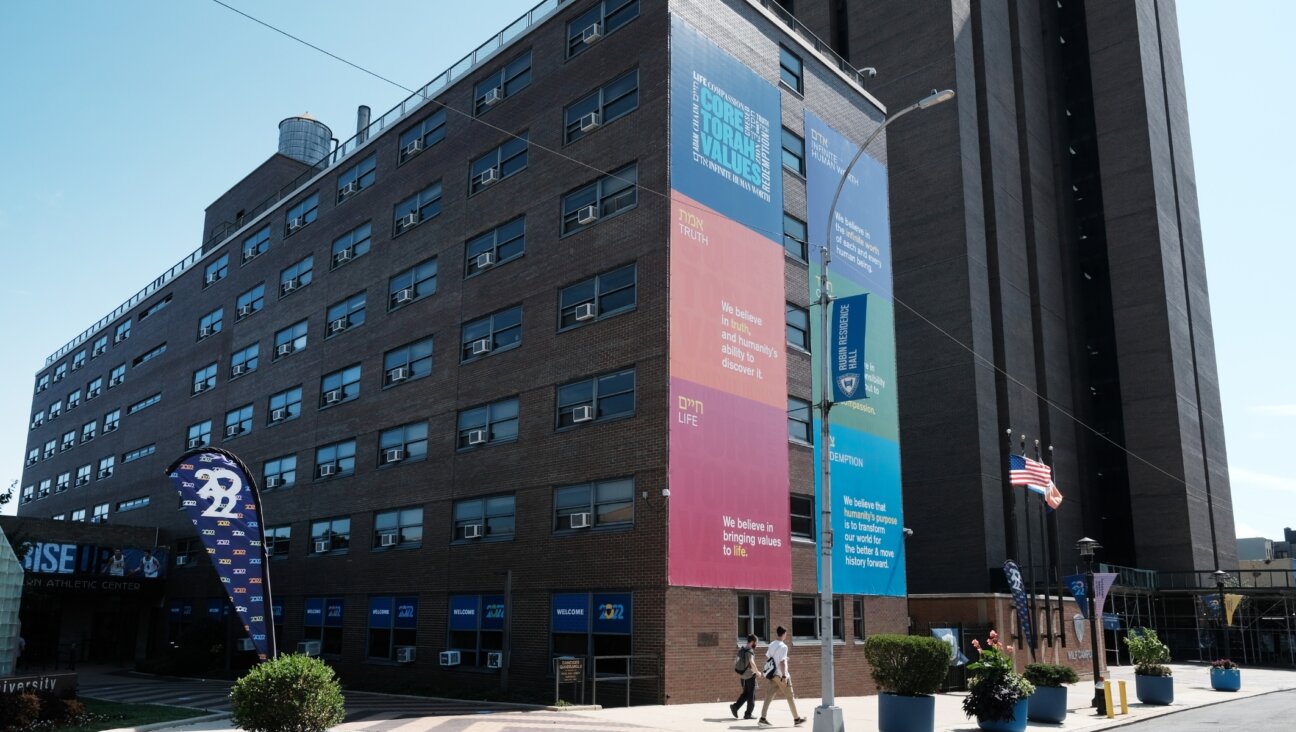Britain’s Chief Rabbi Raises His Profile in America
Most of what you need to know about Jonathan Sacks, the chief rabbi of the British commonwealth, is apparent from the story he tells of how his latest book, “The Home We Build Together,” came to be.
It begins in the prime minister’s study at 10 Downing St., where Sacks would go “regularly” to study the Bible with former British leader Tony Blair. During one of their meetings, Blair – who Sacks describes as a “very religious man” who reads the Bible daily – asked why only 34 verses are needed to describe the creation of the world, but more than 10 times as many to account for the building of the mishkan, the tabernacle the Israelites built in the desert after the Exodus.
Caught off-guard, Sacks offered an answer he considered insufficient. Only later, when Britain and other Western European democracies found themselves enduring spasms of social tension brought on by the alienation of young Muslim immigrants, did he arrive at a more thorough understanding. The problem Europeans were facing, Sacks says now, is precisely the problem the Jews faced in the desert: how to unite a diverse people into a nation.
“God does the most unexpected thing of all,” Sacks explained in a recent lecture in New York. “He says to Moses in effect, ‘You want to turn a fractious group of individuals into a nation, a responsible nation, that coheres? Get them to build something together. Get them to build a house for me.’ ”
In a manner that is fast becoming his signature, Sacks took that biblical insight and used it to fashion a book-length assessment of the failure of British multiculturalism. One of the book’s chapters, titled “Face-to-Face and Side-by-Side,” went on to became the title of a British government report aimed at promoting better relations between the country’s religious communities.
“The government had enormous problems thinking the problem through,” Sacks told JTA in a recent interview. “I realized that I had solved a problem that they were struggling with.”
The man London’s Jewish Chronicle refers to as “The Chief” occupies a peculiar perch in the rabbinic universe. He is a religious figure who has the ear of the most powerful leaders of a largely secular country. Though his flock comprises the 300,000 Jews of the commonwealth, he is best known for commenting on wider social and cultural issues. And in an era when chief rabbis are often viewed as either inglorious or irrelevant – or both, in the case of the scandal-plagued rabbinate in Israel – Sacks has managed to retain a far-ranging influence through his prolific writings and frequent appearances on television and radio.
“Dr. Sacks is one of the handful of religious figures in Britain today who is as well known outside his own faith community as within it,” the Independent wrote in a profile. “Among non-Jews he is a figure of some considerable stature, a staunch defender of the interests of his own people, but one whose stance makes a significant contribution to society’s debate on the big social issues of the day.”
Sacks has been in the news lately for his work on the new Koren siddur, the first new American Orthodox translation of the prayer book in a generation. Its publisher hopes the siddur will become the predominant prayer text in Modern Orthodox congregations, ousting the ArtScroll Siddur, which is written from a fervently Orthodox perspective.
Sacks has nothing but praise for ArtScroll, though at earlier points in his career he may have had more to say on issues of religious politics. He earned scorn for his role in denying synagogue honors to the man voted the greatest British Jew of all time by readers of the Jewish Chronicle in 2005, the controversial British Rabbi Louis Jacobs, who had run afoul of the Orthodox establishment for his supposedly heretical writings. (Sacks wasn’t even a finalist.)
Perhaps the lowest point in his tenure came when a letter was leaked in which he said a popular Reform rabbi who had died was “amongst those who destroy the faith.”
These days, however, Sacks appears bent on staying above the fray. He artfully dodges a question about Pope Benedict XVI’s recent speech at Yad Vashem, which was lambasted publicly by former Israeli Chief Rabbi Yisrael Lau. Sacks makes do with platitudes about Jewish-Catholic reconciliation.
Asked what he thought about female rabbis, Sacks launches into a flowery riff about the importance of women in Jewish life.
“The word rabbi means ‘my teacher.’ And can women be teachers of Torah? Absolutely,” Sacks said. “And beyond that, you will have worked out by now that I have no intention of answering questions that I don’t want to answer.”
The questions that most exercise Sacks these days have little to do with parochial Jewish concerns – another noteworthy departure from his Israeli colleagues, who are most often in the news for controversies related to the coercive power they wield in a mostly secular country. His second decade in office was inaugurated in 2001 with a call to Jewish responsibility, as opposed to the more inward-focused idea of Jewish renewal, which was the theme of his first.
Sacks believes that Jews, as a people with a long history of living as a minority, have much to teach contemporary societies struggling to integrate recent arrivals. But he warns that a model of dialogue between faith leaders, what he calls the “classic model” of interfaith understanding, is unequal to the task.
Dialogue is “an elite activity,” Sacks says, and the problems are “down there on the street.” Moreover, with Muslims, dialogue will always get bogged down in the Israeli-Palestinian conflict.
“It’s not the major route forward and we should not have high expectations,” Sacks said. “There are some wonderful, wonderful moderate Muslims in Britain and in America and in the Middle East and elsewhere, and I love them and we work with them and we have them in our home and we do things together. But that is not the actual route to a solution of the problem. It is a misconception of the problem.”
Asked about American rabbis who have made such encounters a mainstay of their interfaith efforts, Sacks again has nothing but words of praise.
“That is one avenue,” Sacks said, flashing his penchant for metaphor. “Avenues are very beautiful. It’s a lovely winding lane full of wild flowers and lovely vistas. But it’s not the interstate.”
The Forward is free to read, but it isn’t free to produce

I hope you appreciated this article. Before you go, I’d like to ask you to please support the Forward.
Now more than ever, American Jews need independent news they can trust, with reporting driven by truth, not ideology. We serve you, not any ideological agenda.
At a time when other newsrooms are closing or cutting back, the Forward has removed its paywall and invested additional resources to report on the ground from Israel and around the U.S. on the impact of the war, rising antisemitism and polarized discourse.
This is a great time to support independent Jewish journalism you rely on. Make a gift today!
— Rachel Fishman Feddersen, Publisher and CEO
Support our mission to tell the Jewish story fully and fairly.
Most Popular
- 1

Fast Forward Ye debuts ‘Heil Hitler’ music video that includes a sample of a Hitler speech
- 2

Opinion It looks like Israel totally underestimated Trump
- 3

Culture Cardinals are Catholic, not Jewish — so why do they all wear yarmulkes?
- 4

Fast Forward Student suspended for ‘F— the Jews’ video defends himself on antisemitic podcast
In Case You Missed It
-

Culture How one Jewish woman fought the Nazis — and helped found a new Italian republic
-

Opinion It looks like Israel totally underestimated Trump
-

Fast Forward Betar ‘almost exclusively triggered’ former student’s detention, judge says
-

Fast Forward ‘Honey, he’s had enough of you’: Trump’s Middle East moves increasingly appear to sideline Israel
-
Shop the Forward Store
100% of profits support our journalism
Republish This Story
Please read before republishing
We’re happy to make this story available to republish for free, unless it originated with JTA, Haaretz or another publication (as indicated on the article) and as long as you follow our guidelines.
You must comply with the following:
- Credit the Forward
- Retain our pixel
- Preserve our canonical link in Google search
- Add a noindex tag in Google search
See our full guidelines for more information, and this guide for detail about canonical URLs.
To republish, copy the HTML by clicking on the yellow button to the right; it includes our tracking pixel, all paragraph styles and hyperlinks, the author byline and credit to the Forward. It does not include images; to avoid copyright violations, you must add them manually, following our guidelines. Please email us at [email protected], subject line “republish,” with any questions or to let us know what stories you’re picking up.













